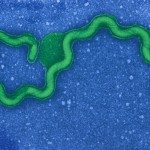Link to Pubmed [PMID] – 25388132
Curr. Top. Microbiol. Immunol. 2015;387:43-63
Recent advances in molecular genetics, such as the ability to construct defined mutants, have allowed the study of virulence factors and more generally the biology in Leptospira. However, pathogenic leptospires remain much less easily transformable than the saprophyte L. biflexa and further development and improvement of genetic tools are required. Here, we review tools that have been used to genetically manipulate Leptospira. We also describe the major advances achieved in both genomics and postgenomics technologies, including transcriptomics and proteomics.

